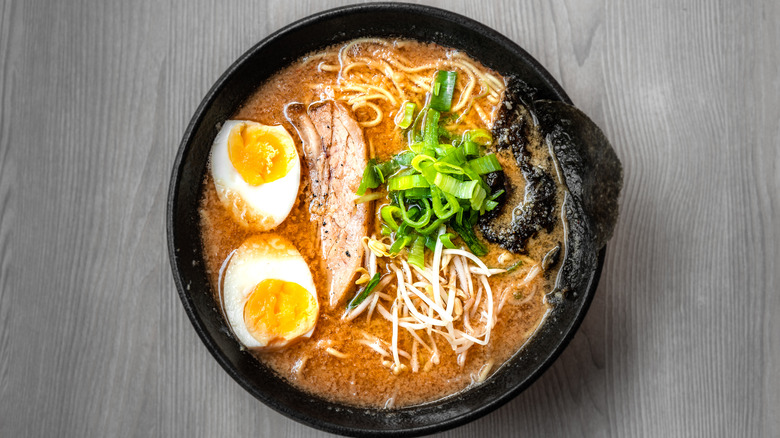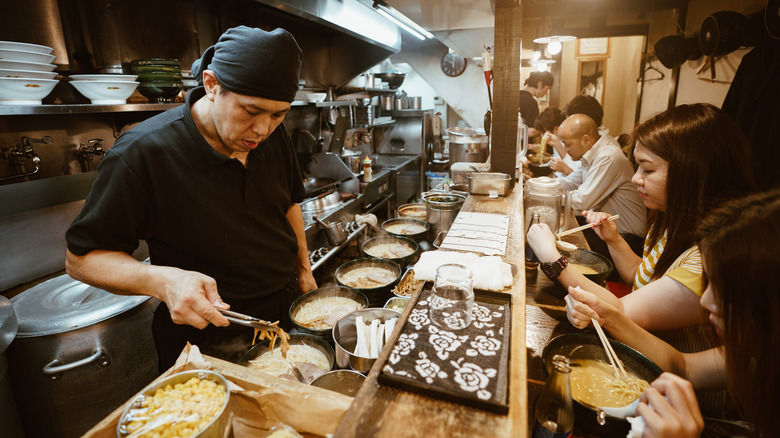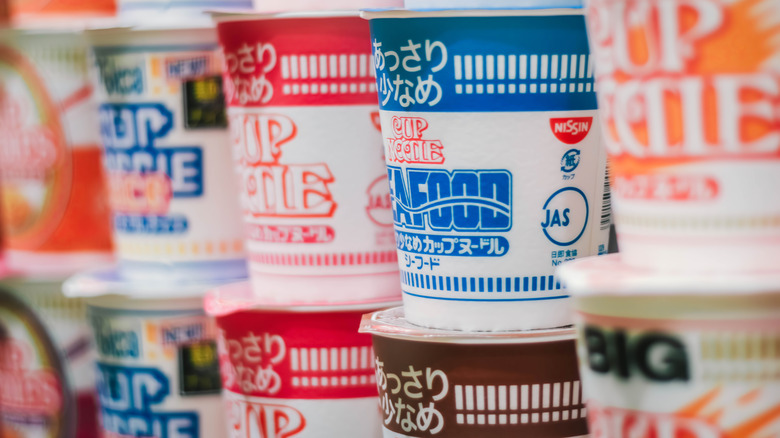The Rarely Known Origin Of Ramen
Whether you're a hungry student looking for late-night study-session fuel, a harried parent looking for a quick and easy dinner for the family, or a gourmand breathing deep over a wide bowl at one of the best ramen restaurants in the country, chances are ramen has been there for you. To say that the noodle soup is having a moment would be an understatement; the Food Channel traces ramen's rise in popularity — its moment — to the early 2000s, but the meal possesses an almost supernatural staying power.
That could be, in part, due to the fact that ramen is, though technically a dish, not a monolith. It takes many forms, from reserved to bold, highbrow to low, relatively expensive to reasonably affordable, explains Serious Eats. There are vegetarian versions and broths creamy with long-steeped bones. Beef, pork, chicken, seafood, and tofu all find a happy home next to a panoply of vegetables and the one constant: the iconic, eponymous, chewy, pale-yellow noodles that make ramen what it is.
But for as much as we in the United States love to slurp up a bowl of these tasty noodles, rarely do we ask about ramen's origin story, though we should. Ramen, not unlike dishes the world over, has a fascinating provenance that is worth a brief recounting if, for nothing else, then to make your next bite taste a bit richer.
Where is ramen from?
Ramen is Japanese, right? Well, yes, but it's not quite that simple — as if anything ever is. Japan and nearby neighbor China have long historical and cultural ties, and ramen is one of those, points out Ramen Culture. After Japan ended its formal isolation in the 1860s, Chinese migrants crossed the East China Sea and settled in Japan, especially Yokohama. It was there they introduced a style of preparing noodles that caught on, initially known as "Nankin soba", a combination of the Japanese pronunciation of the Chinese region of Nanjing and the name of an already-popular type of noodle.
In the post-WWII era, Japan was reeling from food shortages, according to The New Yorker. The outlet reported on a talk by George Solt, an assistant history professor at New York University, who explained that while occupying Japan after the war, the United States was worried about the global spread of Communism. Hunger and access to food, it seemed, played a large role in the growth and popularity of communism in many regions and keen to keep Japan on the side of capitalist democracy, Americans made sure Japan had access to plenty of imported wheat. This glut of wheat was in turn used for noodle production.
An instant success
In 1958, a revolution in the world of ramen occurred, one that set it on the path to the esteem it enjoys today. According to Vox, it was in that year that an enterprising culinary inventor Momofuku Ando invented instant ramen (And yes, David Chang's restaurant empire is named in homage to Momofuku). While experimenting with recipes, Momofuku hit on a unique method of flash-frying precooked noodles, drying them in such a way that they quickly reconstitute in hot water. Though that alone would be enough to cement his legacy, Lucky Peach explains that in 1971 Momofuku rolled out another innovation inspired by his observation of American supermarket executives reusing Styrofoam coffee cups for instant ramen: Cup Noodles (via Gizmodo).
Today, ramen is food royalty. It spans the globe as a national symbol of Japanese gastronomy, First We Feast explains. Ramen shops there remain highly-personal businesses that have shied from corporate dominance and homogenization. The industry has even grown beyond eateries, with two different Japanese museums dedicated to the noodles – ramen as a whole and instant ramen, specifically.


